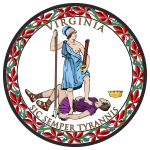On February 29, 1824, Representative William Lee Ball (DR) of Virginia's 13th district died in office. A special election was held to fill the resulting vacancy.
| Elections in Virginia |
|---|
 |
On February 29, 1824, Representative William Lee Ball (DR) of Virginia's 13th district died in office. A special election was held to fill the resulting vacancy.
| Candidate | Party | Votes [1] | Percent |
|---|---|---|---|
| John Taliaferro | Democratic-Republican | 455 | 55.8% |
| John P. Hungerford | Federalist | 359 | 44.0% |
| William Hungerford | 1 | 0.1% |
These are tables of congressional delegations from New Jersey to the United States Senate and United States House of Representatives.

The 1824–25 United States House of Representatives elections were held on various dates in various states between July 7, 1824, and August 30, 1825. Each state set its own date for its elections to the House of Representatives before the first session of the 19th United States Congress convened on December 5, 1825. Elections were held for all 213 seats, representing 24 states.

Pennsylvania elected its members October 12, 1824.

The 1824–25 United States Senate Elections were held on various dates in various states. As these U.S. Senate elections were prior to the ratification of the Seventeenth Amendment in 1913, senators were chosen by state legislatures. Senators were elected over a wide range of time throughout 1824 and 1825, and a seat may have been filled months late or remained vacant due to legislative deadlock. In these elections, terms were up for the senators in Class 3.
Massachusetts elected its members November 4, 1822. Massachusetts law required a majority for election, which was not met in 3 districts, necessitating additional elections on March 3, 1823, and May 12, 1823; nevertheless, all elections were complete before the new Congress convened.
A special election was held for the Indiana's 1st district after William Prince (DR-Jackson) died on September 8, 1824.
On October 15, 1824, Charles Rich of Vermont's at-large district died in office. A special election was held for his replacement.

On March 23, 1824, Hutchins G. Burton (DR), who had represented North Carolina's 2nd district, resigned upon being elected Governor. A special election was held to fill the resulting vacancy on January 6, 1825

On April 20, 1824, Thomas J. Rogers (DR) of Pennsylvania's 8th district resigned, leaving a vacancy which was filled by a special election on October 12, 1824, the same day as the general election for the 19th Congress.

In June 1824, John Tod (DR) of Pennsylvania's 13th district resigned. A special election was held to fill the resulting vacancy on October 12, 1824, the same day as the elections to the 19th Congress

Georgia elected its members October 4, 1824. There were only 7 candidates who ran statewide in 1824. There were several other candidates who received votes in a small number of counties, but vote totals were only available for the seven winning candidates. The minor candidates only received a few hundred votes each.
Indiana elected its members August 2, 1824.

Kentucky elected its members August 2, 1824.

South Carolina elected its members October 11–12, 1824.

Vermont elected its members September 7, 1824. Congressional districts were re-established in Vermont for the 1824 election. Vermont had used an at-large district 1812-1818 and 1822. A majority was required for election, which was not met in the 1st district, necessitating a second election December 6, 1824.
A special election was held in Massachusetts's 10th congressional district to fill a vacancy caused by John Bailey (DR) being declared not eligible for the seat which he'd won the previous year on March 24, 1824. The election was held on August 30, 1824, with additional ballots held on November 1 and November 29 due to a majority not being achieved on the first or second ballot.

The 1824 United States elections elected the members of the 19th United States Congress. It marked the end of the Era of Good Feelings and the First Party System. The divided outcome in the 1824 presidential contest reflected the renewed partisanship and emerging regional interests that defined a fundamentally changed political landscape. The bitterness that followed the election ensured political divisions would be long-lasting and facilitated the gradual emergence of what would eventually become the Second Party System. Members of the Democratic-Republican Party continued to maintain a dominant role in federal politics, but the party became factionalized between supporters of Andrew Jackson and supporters of John Quincy Adams. The Federalist Party ceased to function as a national party, having fallen into irrelevance following a relatively strong performance in 1812.
The 1826 United States elections occurred in the middle of Democratic-Republican President John Quincy Adams's term. Members of the 20th United States Congress were chosen in this election. The election took place during a transitional period between the First Party System and the Second Party System. With the Federalist Party no longer active as a major political party, the major split in Congress was between supporters of Adams and supporters of Andrew Jackson, who Adams had defeated in the 1824 Presidential election.

Virginia elected its members in April 1825, after the term began but before the new Congress convened.
Massachusetts elected its members November 1, 1824. Massachusetts had a majority requirement for election, which necessitated additional elections held January 3, 1825, April 1, 1825, and August 1, 1825.